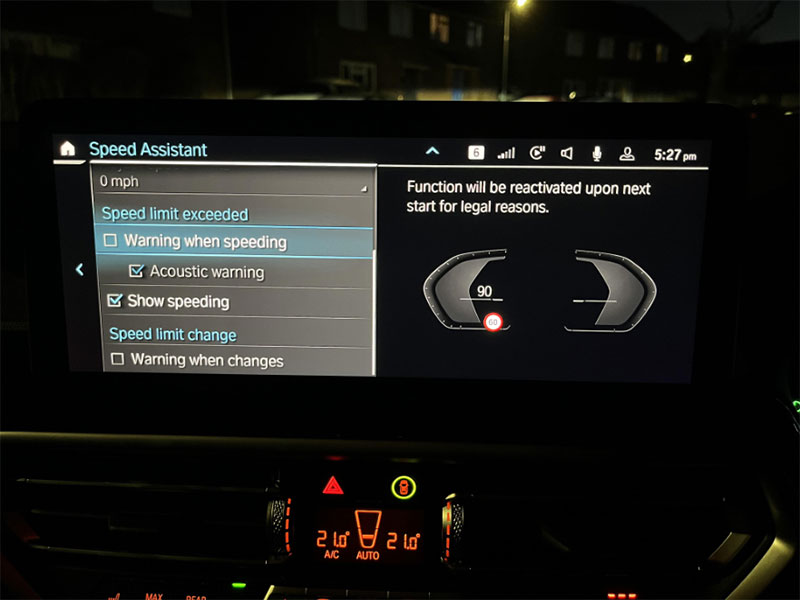The BMW Speed Limit Warning is an essential feature that alerts drivers when they are exceeding the set speed limit. While it’s a helpful tool for safety-conscious drivers, any malfunction in this system can result in constant warnings or even a speed restriction while driving. Understanding the causes of this issue and how to fix it is crucial for both automotive engineers and workshop owners.
In this guide, we’ll break down the root causes of BMW Speed Limit Warning failures, provide instructions on how to fix the problem, and offer support options from Cardiagtech for online repairs.
Why Does the BMW Speed Limit Warning Malfunction?
The BMW Speed Limit Warning works in conjunction with the vehicle’s cruise control system and is designed to limit the vehicle’s speed, preventing drivers from unintentionally exceeding the set speed, particularly in speed-restricted zones like residential areas. This feature communicates with the engine control system (DME) and automatic transmission control system (EGS) to adjust the vehicle’s speed based on predefined limits.
However, this system may malfunction due to various factors, including:
- Faulty connections between the speed limit module and the control systems.
- Loose plug connections or corroded wiring harnesses.
- Communication failures between the DME (engine control unit) and the speed limit module via the FlexRay bus.
Symptoms of BMW Speed Limit Warning Issues
If the BMW Speed Limit Warning malfunctions, drivers may notice the following symptoms:
- Flashing speed limit warning light on the dashboard.
- Inability to exceed a certain speed, even when pressing the accelerator.
- Temporary system failure when going downhill or under heavy acceleration, with the warning light flashing but not completely deactivating.
These symptoms can be highly disruptive, affecting the overall driving experience, particularly on highways or steep inclines. It is essential to diagnose and repair the issue to restore normal functionality.
Step-by-Step Guide to Fixing BMW Speed Limit Warning
If you’re an automotive engineer or workshop owner, you can fix the BMW Speed Limit Warning with the following steps:
- Inspect the Wiring Harness for the Steering Wheel
- A common cause of malfunction is a damaged wiring harness connecting the steering wheel to the control modules. Check for any signs of wear, disconnection, or corrosion in the harness assembly.
- Examine the Airbag Clock Spring (Hairspring)
- The airbag clock spring is responsible for maintaining electrical connections while the steering wheel is in motion. Inspect the hairspring for any signs of failure, as a broken or damaged spring could affect the system’s ability to communicate with the vehicle’s electronics.
- Check the Steering Column Switch Center (SZL)
- The SZL controls various steering wheel functions, including the speed limit system. If the SZL is faulty or damaged, the speed limit warning may malfunction. Inspect the switch center and replace any faulty parts.
- Reprogram and Recode the Speed Limit Module
- If the above steps do not resolve the issue, the next course of action is to reprogram and recode the speed limit module. This process involves connecting to the vehicle’s diagnostic system using software like Xentry or ISTAD, which can be done online through Cardiagtech’s remote diagnostic services.
Online Support from Cardiagtech
For complex issues related to the BMW Speed Limit Warning system, workshop owners and automotive engineers can turn to Cardiagtech for professional assistance. Our expert technicians specialize in diagnosing and fixing speed limit system issues through online remote services. We provide:
- Full diagnostic support: Using remote coding and programming software like Vediamo and Xentry, we can assist you in identifying and resolving module malfunctions.
- Affordable repair solutions: Our services are designed to be cost-effective, providing quick, efficient fixes without the need for expensive part replacements.
- 24/7 Technical Assistance: Whether you’re working on-site at your garage or need help in real-time, our technical support team is available around the clock to assist you.
To book a session or inquire about our remote services, simply reach out via WhatsApp or contact us through our website. We’ll guide you through the entire process, ensuring that your BMW’s speed limit system is restored to its optimal performance.
Q&A Section
Q: Can I fix the BMW Speed Limit Warning by myself?
A: Yes, if you’re an experienced automotive engineer or workshop owner, you can inspect and fix some basic issues, such as checking the wiring harness or replacing faulty components. For complex problems involving recoding and reprogramming, it’s recommended to seek expert help through remote services like those offered by Cardiagtech.
Q: What tools do I need to fix the BMW Speed Limit Warning?
A: You will need diagnostic tools such as Xentry or Vediamo software, along with a compatible interface like C4 or C6 DoIP, to reprogram the speed limit module. Additionally, basic tools like a multimeter and a wiring harness inspection tool will be necessary for troubleshooting electrical connections.
Q: How can Cardiagtech help me with fixing BMW Speed Limit Warning?
A: Cardiagtech provides remote diagnostic services, including module recoding and reprogramming, which can be done online. Our technical experts can guide you step by step through the process, ensuring a quick and effective fix.
Q: What should I do if the warning persists after replacing the parts?
A: If the warning light continues to flash after replacing the wiring harness or SZL, the issue may lie in the coding of the module itself. Reprogramming and recoding the module through specialized software is recommended.
For assistance in fixing BMW Speed Limit Warning errors, contact Cardiagtech now for remote diagnostic support! Our expert technicians are ready to help you restore your BMW’s speed limit system to full functionality. Reach out via WhatsApp at +1 (641) 206-8880 for more information.

